Get Off the Escalator! “Teaching” is Active and Intentional.
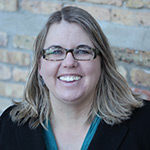
Sara Van Der Werf
Teacher, Minneapolis South High School
MCTM President
In recent years I’ve showed a video of a man and a woman on an escalator to my students each year. (You can watch it HERE, it takes only 2 minutes) The escalator stops in the video and the man and woman start screaming for help. Hours pass and you see the 2 individuals sitting on the escalator waiting for help to arrive. As I show the video my students laugh and some scream “Walk!” Essentially my students are telling the people in the video to DO something, that they have the power to change their circumstances. I tell my students that many times they look as silly as the people in the video in math class. I say “This year if I see you sitting there without a pencil doing nothing, I will say ‘get off the escalator’ meaning I want you to do something to solve your problem”.
The message of this video is not just great for my students, it is also totally appropriate for those of us who teach mathematics. I think we (math teachers) at times know that things are not working in our classroom and we scream for help. Sometimes these screams for help are internal, we don’t want anyone to know what we know, that what we are doing is not working. We make excuses. We waste time wishing to teach a different group of students. What we fail to do at times is to actively do something that could change the outcomes in our classrooms.
As we enter 2016, my wish for the all teachers is that we would stop wasting time making excuses for why our students are not learning, we would not waste time wishing for students to arrive with more skills than they have. I wish we would see the assets our students do arrive with. I wish for all of us that we would actively do something different if our students are not successful. My wish for 2016 is that all of us would ‘get off the escalator’ and make intentional choices in our teaching.
This article is part 3 of an 8 article series highlighting 8 words in the MCTM Mission Statement highlighting the word ‘TEACHING‘. (Here are links to part 1: ‘PROFESSIONALS’ or part 2: ‘PROMOTING’) I, as President, am MCTM. You as a member of our organization are MCTM. Our mission statement gives us direction around our profession. In my series of articles I hope to give insight into 8 of the words it contains and how they inform our practice. Please take a moment to reread our mission statement.
January and February’s articles highlight the words ‘Teaching and Learning’. As I sat down to write this article it was tough to separate these 2 words because they are so intertwined. Teaching and learning are inseparatable. I am sure many of you have seen this comic at one of your professional development sessions in the last several years. It is a simple comic we should all hang above our desks. It reminds us that not everything we do that looks like ‘teaching’ is successful. We need to make sure students have learned something. In February I will talk about what it means to ‘learn’ something. This month I will talk about the only thing that we can control in the process and that is ‘teaching’.
Let’s start by looking at ‘teaching’ from NCTM’s Principles to Actions (2014) book. Afterward I will give you a few practical things that have worked for me in my classroom around teaching. NCTM writes, “Teachers’ beliefs influence the decisions that they make about the manner in which they teach mathematics”. (page 10) WOW! What I believe influences my decisions as a teacher. What I love about NCTM’s publication is they include lists of ‘unproductive’ and ‘productive’ beliefs. What I know for sure is I want to spend my time on beliefs that are productive (meaning they get me off the escalator) Please take a moment to read NCTM’s list.
NCTM’s Principles to Actions book (2014) then goes on to list 8 Mathematics TEACHING practices:
- Establish mathematics goals to focus learning.
- Implement tasks that promote reasoning and problem solving.
- Use and connect mathematical representations.
- Facilitate meaningful mathematical discourse
- Pose purposeful questions.
- Build procedural fluency from conceptual understanding.
- Support productive struggle in learning mathematics.
- Elicit and use evidence of student thinking.
I could write a book on each of these 8 practices of excellent teaching, but why should I? NCTM already did. You need to read NCTM’s Principles to Actions book. If you don’t read this book, then read ‘5 Practices for Orchestrating Productive Math Discussions’ by Margaret S. Smith & Mary Kay Stein (they helped write Principles to Actions so there is a lot of overlap in the 2 texts. Get off the escalator and learn about best practices in teaching. Choose at least one of these things to get better at in 2016.
So practically what does ‘teaching’ look like in a classroom? I can only give you a window into what I am working on in my own teaching right now. Here are a few examples.
- I have a personal measure of what a good day of teaching looks like in my classroom. I reflect on this measure each day. If it is not met, I work to figure out what I can do differently, what I can tweak in my teaching to improve outcomes for my students. A good day in my mathematics classroom is when every student is cognitively engaged in the learning of mathematics. Notice I did not say students are quiet or that students are well behaved or that they are all compliantly doing what I asked of them. What I look for each day is ‘are my students brains turned on?’. Are they curious? Are they excited about the mathematics they are learning? Are they ALL engaged? If not, I need to figure out why and tweak something. I encourage you to enter 2016 taking 5-10 minutes each day to reflect on this question “Was every student cognitively engaged in learning mathematics today?” Ask yourself, how do you know? If they are not all engaged (and often I have at least a few that are not) ask yourself why not and try to improve on this.
- I refuse to engage in any more talk about students not knowing their math facts. I am sick of complaining about it. Complaining has gotten me & my students nowhere. NOWHERE. Every year we have the same complaints, but we have not changed anything in our teaching. Changing MY teaching (vs. waiting for others to change their teaching) is the only thing I can control. In 2016, I encourage everyone to learn/read/talk about how students develop number sense and computational fluency. For me I started reading and using Number Talks. Doing something about my student’s lack of computational fluency has radically changed the engagement in my classroom. I encourage you to join me in learning about this (it should not be left solely to K-3 teachers). This is all our work.
- The choice of mathematical task in my teaching is key. Selecting tasks that have entry points for all levels of students and also challenge all students is so important to students being cognitively engaged. Read my article on my favorite task to learn more. To select the right task I need to know what my students entry points are. This means I need to study my students.
- Success in the classroom begins with relationships. Every day I make choices in my teaching that lead to deeper relationships with my students.
- Using ‘Exemplars’ of the type of work I expect from students and ‘Modeling’ for students what it looks like to do math in my classroom have been the most important things I’ve done in my teaching. If I want students to talk about mathematics in my classroom I need to model it. I need to teach it. Don’t forget that we are not just teaching students mathematics content, we are also teaching students how to learn mathematics. Here is one post of what modeling group work looks like in my classroom if you want to learn more.
- One of the things that was bugging me about my own teaching this year is that many of my students would give up thinking about a problem within 30 seconds if they found it too hard. My professional learning community is working on finding ways to create persistent, excited, curious and engaged learners. As part of my work towards this goal, I found this quote from Malcom Gladwell and used it in my classroom. The results have been amazing. I think it has something about giving students a specific time (22 minutes). My students have increased the time they work on tasks. It has been amazing. You can read about how I used this quote (and the escalator video) here.
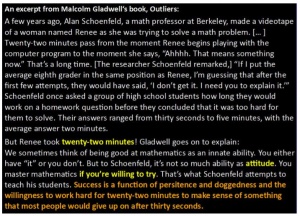
- The thing I use most often in planning what I teach is creating mathematical experiences where I can ask students “What do you notice?” and “What do you wonder?”. I take math tasks I’ve used in the past and restructure them so I can ask these questions. If I can’t ask these questions in what I plan to teach, then I know I am may need to start over with a new task. If you’ve not watched Annie Fetter’s 5 minute video on these questions, do so now.
- Small tweaks in our teaching make a huge difference. Recently I was teaching exponents and logarithm rules to my students. I researched what other teachers did when they taught these topics and found a couple of key tweaks I could make to the language I used with my students. I shared this with the teacher I co-plan with. At the end of the unit we were both amazed at what a huge difference these small tweaks made in all students developing a conceptual understanding of logarithms and (If you want to know more, click on the prior links to see the tweaks I made to my language). My wish for you is that at the start of every unit you research best practices for teaching the topics you are teaching. Be a learner. Often the changes we need to make are small and easy to implement.
I want to end with some blunt talk. We are teaching mathematics. Teaching is not tutoring. Teaching is not explaining mathematics step by step and having students mimic us. I get why we do this. It is easy to control behavior using this method. It is easy to create a classroom that is quiet and to get all students compliantly doing something using this method. What I know though is this method is not what teaching should look like. Teaching is messy. Teaching is an art. Teaching mathematics is showing students where to look but not telling them what to see. Teaching mathematics is creating learning experiences for students where they develop understanding of concepts. Teaching mathematics is figuring out how to get every student cognately engaged in thinking about mathematics. It is about creating mathematically curious and excited students. Mathematics Teaching is about the teacher beliefs and choices we make in the classroom.
When I worked as the K-12 Math Lead at my districts central office I had a tag line at the end of my emails. The one that was there the longest read ‘Be Intentional.’ When I did professional development with math teachers I encouraged them to ‘Be Intentional’ in the choices they made in their teaching. I asked them to not just ask questions in the classroom spur of the moment, but to intentionally plan great questions to ask. Years later teachers tell me that they use this short phrase in their planning to this day. In 2016, I ask all of you (and myself) to be intentional in the teaching you do in the classroom. Be a learner. Read something. Research something. Observe someone. Be Intentional in your teaching choices.
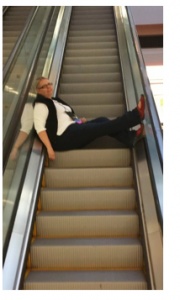 During the November NCTM Regional in Minneapolis there was a broken escalator in the middle of the conference. Several of us who have used the broken escalator in our classrooms used this time to videotape ourselves on the escalator. I challenge you to ask yourself if the decisions you make about your teaching are more like the people in the video sitting on the broken escalator or are you actively doing something to improve your teaching and walking off the escalator.
During the November NCTM Regional in Minneapolis there was a broken escalator in the middle of the conference. Several of us who have used the broken escalator in our classrooms used this time to videotape ourselves on the escalator. I challenge you to ask yourself if the decisions you make about your teaching are more like the people in the video sitting on the broken escalator or are you actively doing something to improve your teaching and walking off the escalator.
Teaching must be measured by its results – learning. Look for my article on ‘learning’ in the February 1st issue of MathBits. I love connecting with math teachers, especially those of you from Minnesota. You can find me on Twitter @saravdwerf or Email me at sarav@mpls.k12.mn.us or check out my Math Teaching blog at saravanderwerf.com
Postscript: I just found this great link from Max Ray of videos of ‘Doing and Teaching Math’. These might be a great place for you to refresh your idea of what ‘teaching’ math looks like. Enjoy.


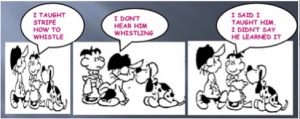
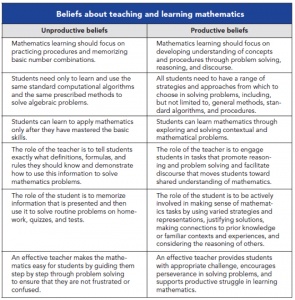
Sara,
I do miss your wonderful ideas! Hope to see you in Duluth,
Judy (: